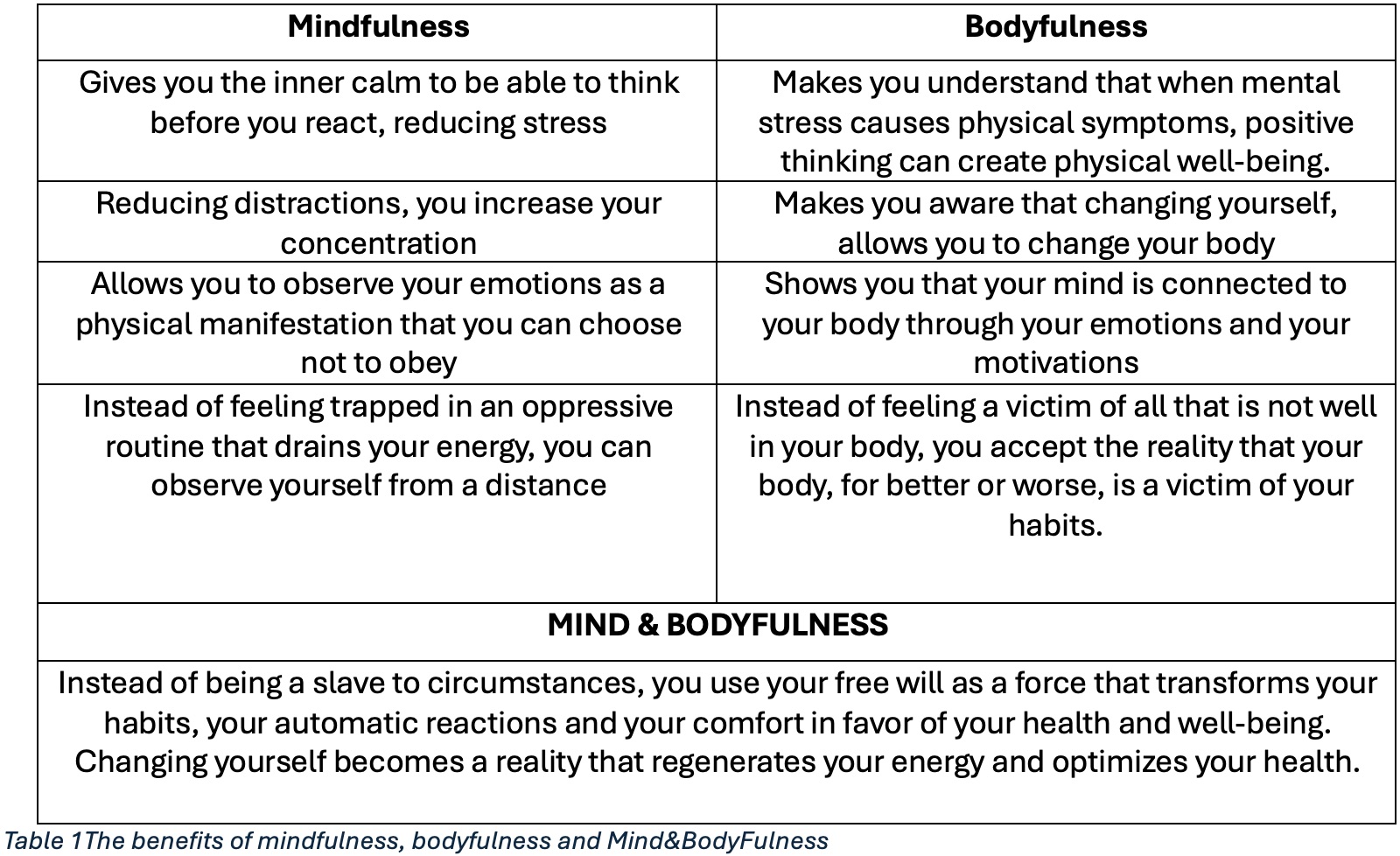Mindfulness and Bodyfulness: What They Are and What Problems They Solve
Mindfulness, you've heard of it or you've already tried it a few times. But now you want to learn more about its value for your well-being. You'll also discover what bodyfulness is and how you can start practicing it right away.
Mindfulness and Bodyfulness: Taking Charge of Yourself
Mindfulness and bodyfulness have become increasingly popular practices due to their benefits for mental and physical well-being. For those who want to live in their strength, they are indispensable practices because, in order to live well, we all need to manage our thoughts, our emotions and our body well.
Problems you can improve with Mind&BodyFulness
 When combined, mindfulness and bodyfulness can give you back the control over yourself. Problems such as difficulty concentrating, panic attacks, anxiety, general stress and sleep disorders gradually return under your control. But even chronic pain such as fibromyalgia, rheumatism or muscle tension will decrease or disappear completely. After all, you know that the way you manage your thoughts and emotions can worsen your health. Mind&BodyFulness puts you back in your strength!
When combined, mindfulness and bodyfulness can give you back the control over yourself. Problems such as difficulty concentrating, panic attacks, anxiety, general stress and sleep disorders gradually return under your control. But even chronic pain such as fibromyalgia, rheumatism or muscle tension will decrease or disappear completely. After all, you know that the way you manage your thoughts and emotions can worsen your health. Mind&BodyFulness puts you back in your strength!
In practice, what are Mindfulness and Bodyfulness?
Practising mindfulness means bringing your attention to the present, intentionally and without judgment. Acknowledging the reality of the world around you and within you, without being overwhelmed and without judgment.
Practising bodyfulness, instead, is the awareness that everything that happens in your mind produces a physical manifestation, for better or worse.
A practical example of Mindfulness
 One way to practice mindfulness is to put yourself in a pleasant place, such as a quiet forest. Make yourself comfortable and it all starts when you stop doing and start feeling. This means you stop producing thoughts about what to do next and about what happened in the past. You take control of your attention and start directing it to what you choose.
One way to practice mindfulness is to put yourself in a pleasant place, such as a quiet forest. Make yourself comfortable and it all starts when you stop doing and start feeling. This means you stop producing thoughts about what to do next and about what happened in the past. You take control of your attention and start directing it to what you choose.
It is usually best to start by bringing your attention to something outside of yourself. In our example we are in a forest and you might choose to bring your attention to a flower or a tree that you like. Now begin mindfulness. Many, many things tend to take your attention away from what you have chosen and that you like. It can be thoughts and feelings or noises and movements around you. You may also notice that simply keeping your attention on one thing, creates discomfort (often caused by how we use social media as you can see in this article).

As you practice keeping your attention resting comfortably on something pleasant, you begin to notice some positive effects. Imagine that you have brought your attention to a majestic tree because it gives you a sense of peace, or to a flower that makes you feel serene. What will happen when you remain there with your attention? These sensations will become stronger!
The more you can enjoy these effects without letting your attention be distracted, the greater the positive effect will be!
You can certainly choose to bring your attention to something else but make sure you do it by choice and not by distraction.
The practice of mindfulness also has risks that I will tell you about in this article.
A practical example of Bodyfulness How many times have you found yourself interpreting a person's body language to understand their intentions or mood? In fact, we do it all the time. This shows that we all believe that what you think and feel dominates how you use your body. We have a much harder time doing the same thing with ourselves, though. We easily hide this awareness of ourselves under the phrase: “I am just the way I am!”
How many times have you found yourself interpreting a person's body language to understand their intentions or mood? In fact, we do it all the time. This shows that we all believe that what you think and feel dominates how you use your body. We have a much harder time doing the same thing with ourselves, though. We easily hide this awareness of ourselves under the phrase: “I am just the way I am!”
Now do bodyfulness in an exercise. Start with the question – why? – . For example: why am I always standing like a sack of potatoes? Now, there is no need to think about the theory, in fact, doing so would prevent you from bodyfulness. You go find in your body your personal answer. While you stand as you are used to, you begin to observe in your mind what you think and see that causes this habitual posture. Of course, the first answer you find is that it is comfortable. But this answer is valid for every habit. Look further.
You may find answers like this:
– Because I don't feel appreciated and therefore it's useless for me to make an effort
– Because I hate being frantic and stressed like others around me and so I keep myself passive
– Because standing straight makes me feel uncomfortable and I don't want to feel that way
Of course, look for your own answer and don't just accept the ones suggested here. With bodyfulness you can be aware of what thoughts, beliefs and feelings are behind your physical behavior.
The practice of bodyfulness also has risks that I will tell you about in this article.
Why is the combination a winning one?
Mindfulness can calm you down because you stop judging and distance yourself from the frenzy. But, when you return to everyday reality you are still the same person because you have not changed anything about yourself yet.
Bodyfulness shows you that what happens in your body depends, consciously or unconsciously, on what happens in your mind. Of course, being aware of it in itself does not change your automatisms or your habits.
Mind&BodyFulness is a way to connect mind and body, improving your ability to react to reality and manage your free will. Being able to transform your habits to your advantage is beautiful!
Try this practical guide to Mind&BodyFulness in this article.
Benefits and problems they solve

